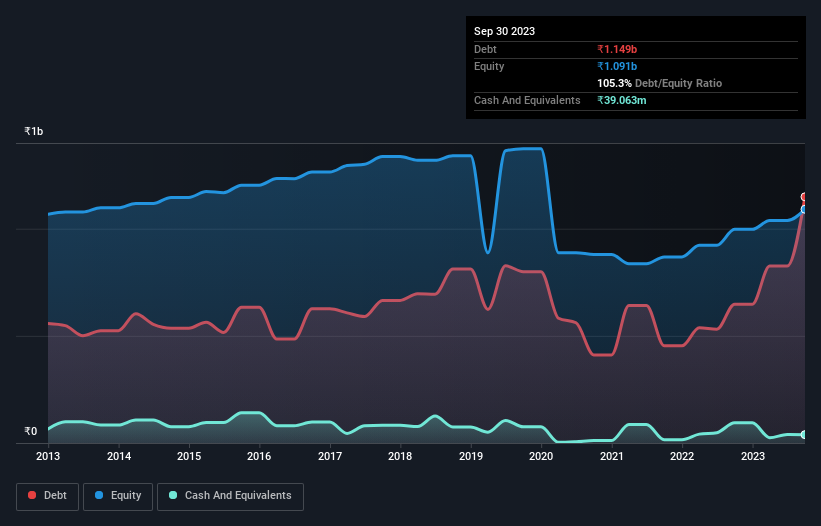- India
- /
- Paper and Forestry Products
- /
- NSEI:ARCHIDPLY
Here's Why Archidply Industries (NSE:ARCHIDPLY) Has A Meaningful Debt Burden
Warren Buffett famously said, 'Volatility is far from synonymous with risk.' So it seems the smart money knows that debt - which is usually involved in bankruptcies - is a very important factor, when you assess how risky a company is. We note that Archidply Industries Limited (NSE:ARCHIDPLY) does have debt on its balance sheet. But is this debt a concern to shareholders?
When Is Debt Dangerous?
Debt is a tool to help businesses grow, but if a business is incapable of paying off its lenders, then it exists at their mercy. In the worst case scenario, a company can go bankrupt if it cannot pay its creditors. However, a more usual (but still expensive) situation is where a company must dilute shareholders at a cheap share price simply to get debt under control. Having said that, the most common situation is where a company manages its debt reasonably well - and to its own advantage. The first step when considering a company's debt levels is to consider its cash and debt together.
Check out our latest analysis for Archidply Industries
What Is Archidply Industries's Debt?
As you can see below, at the end of September 2023, Archidply Industries had ₹1.15b of debt, up from ₹648.0m a year ago. Click the image for more detail. However, it does have ₹39.1m in cash offsetting this, leading to net debt of about ₹1.11b.

A Look At Archidply Industries' Liabilities
According to the last reported balance sheet, Archidply Industries had liabilities of ₹1.27b due within 12 months, and liabilities of ₹533.6m due beyond 12 months. Offsetting this, it had ₹39.1m in cash and ₹915.7m in receivables that were due within 12 months. So it has liabilities totalling ₹845.4m more than its cash and near-term receivables, combined.
While this might seem like a lot, it is not so bad since Archidply Industries has a market capitalization of ₹1.82b, and so it could probably strengthen its balance sheet by raising capital if it needed to. But we definitely want to keep our eyes open to indications that its debt is bringing too much risk.
We measure a company's debt load relative to its earnings power by looking at its net debt divided by its earnings before interest, tax, depreciation, and amortization (EBITDA) and by calculating how easily its earnings before interest and tax (EBIT) cover its interest expense (interest cover). This way, we consider both the absolute quantum of the debt, as well as the interest rates paid on it.
Archidply Industries's debt is 4.7 times its EBITDA, and its EBIT cover its interest expense 3.3 times over. Taken together this implies that, while we wouldn't want to see debt levels rise, we think it can handle its current leverage. Notably, Archidply Industries's EBIT was pretty flat over the last year, which isn't ideal given the debt load. The balance sheet is clearly the area to focus on when you are analysing debt. But it is Archidply Industries's earnings that will influence how the balance sheet holds up in the future. So if you're keen to discover more about its earnings, it might be worth checking out this graph of its long term earnings trend.
Finally, a company can only pay off debt with cold hard cash, not accounting profits. So it's worth checking how much of that EBIT is backed by free cash flow. Over the last three years, Archidply Industries saw substantial negative free cash flow, in total. While that may be a result of expenditure for growth, it does make the debt far more risky.
Our View
Mulling over Archidply Industries's attempt at converting EBIT to free cash flow, we're certainly not enthusiastic. But at least its EBIT growth rate is not so bad. Looking at the bigger picture, it seems clear to us that Archidply Industries's use of debt is creating risks for the company. If everything goes well that may pay off but the downside of this debt is a greater risk of permanent losses. When analysing debt levels, the balance sheet is the obvious place to start. However, not all investment risk resides within the balance sheet - far from it. Case in point: We've spotted 5 warning signs for Archidply Industries you should be aware of, and 2 of them don't sit too well with us.
If, after all that, you're more interested in a fast growing company with a rock-solid balance sheet, then check out our list of net cash growth stocks without delay.
New: Manage All Your Stock Portfolios in One Place
We've created the ultimate portfolio companion for stock investors, and it's free.
• Connect an unlimited number of Portfolios and see your total in one currency
• Be alerted to new Warning Signs or Risks via email or mobile
• Track the Fair Value of your stocks
Have feedback on this article? Concerned about the content? Get in touch with us directly. Alternatively, email editorial-team (at) simplywallst.com.
This article by Simply Wall St is general in nature. We provide commentary based on historical data and analyst forecasts only using an unbiased methodology and our articles are not intended to be financial advice. It does not constitute a recommendation to buy or sell any stock, and does not take account of your objectives, or your financial situation. We aim to bring you long-term focused analysis driven by fundamental data. Note that our analysis may not factor in the latest price-sensitive company announcements or qualitative material. Simply Wall St has no position in any stocks mentioned.
About NSEI:ARCHIDPLY
Archidply Industries
Manufactures and sells wood and paper based products in India and internationally.
Low risk and slightly overvalued.
Similar Companies
Market Insights
Community Narratives



